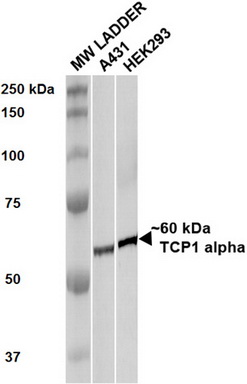TCP1 alpha (TCP1) Rat Monoclonal Antibody [Clone ID: 91a]
Other products for "TCP1"
Specifications
| Product Data | |
| Clone Name | 91a |
| Applications | WB |
| Recommended Dilution | WB: 1:1000 |
| Reactivities | Mouse, Rat, Rabbit, Guinea pig, Hamster, Cow, Dog, Human, Pig, Saccharomyces cerevisiae, Caenorhabditis elegans, Fruit fly (Drosophila melanogaster), Monkey |
| Host | Rat |
| Isotype | IgG2a |
| Clonality | Monoclonal |
| Immunogen | Recombinant Mouse TCP1 alpha protein fragment (carboxy terminal region). |
| Formulation | PBS pH7.4, 50% glycerol, 0.1% sodium azide |
| Concentration | lot specific |
| Purification | Protein G Purified |
| Conjugation | Unconjugated |
| Storage | Store at -20°C as received. |
| Stability | Stable for 12 months from date of receipt. |
| Gene Name | t-complex 1 |
| Database Link | |
| Background | T-complex polypeptide-1 (TCP1) is a ~60 kDa protein constitutively expressed in almost all eukaryotic cells, and is up-regulated during spermatogenesis. It is found in the cytosol as a subunit of a hetero-oligomeric chaperone that is known to be involved in the folding of actin and tubulin. The family of proteins termed chaperonins act to recognize and stabilize polypeptide intermediates during folding, assembly and disassembly, and share many characteristics with Heat Shock Protein 70 (HSP 70) including high abundance, induction by environmental stress, and ATPase activity. The chaperonin family includes the mitochondrial HSP60,Escherichia coli GroEL, the plastid Rubisco-subunit binding protein, and the archaebacterial protein TF55. The TCP1 sequence shows nearly 40% identity to TF55, but only minimal similarity to HSP60 and GroEL. |
| Synonyms | CCT-alpha; CCT1; CCTa; D6S230E; TCP-1-alpha |
| Note | Detects a 60kDa protein corresponding to the molecular weight of TCP1 alpha; also detects a molecular mass band of ~92kDa. Cross reactivity with human Hsp60 has been observed with this antibody in immunoblot analysis. Reacts weakly with Saccharomyces cerevisiae, consistent with the epitope sequence being AKLRS (instead of AKLRA). In C. elegans, it reacts with TCP1 alpha and another CCT subunit. In plants, it recognizes TCP1 of Pisum sativum, and the sequence of Arabidopsis thalania TCP1 over the region of the epitope AKLRA. It has also been shown that it reacts with a subunit of a specialized chaperonin which folds phytochrome. |
| Reference Data | |
Documents
| Product Manuals |
| FAQs |
{0} Product Review(s)
0 Product Review(s)
Submit review
Be the first one to submit a review
Product Citations
*Delivery time may vary from web posted schedule. Occasional delays may occur due to unforeseen
complexities in the preparation of your product. International customers may expect an additional 1-2 weeks
in shipping.






























































































































































































































































 Germany
Germany
 Japan
Japan
 United Kingdom
United Kingdom
 China
China



